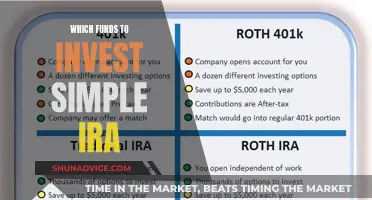
The S&P 500 is a stock market index composed of about 500 publicly traded companies. It is not possible to directly invest in the index itself, but you can buy individual stocks of companies in the S&P 500, or invest in an S&P 500 index fund or ETF. Index funds are considered less risky than individual stocks and can instantly diversify your portfolio.
When investing in an S&P 500 index fund, you can choose between a taxable brokerage account, a 401(k), or an IRA. Some of the best S&P 500 index funds on the market include the Vanguard 500 Index Fund - Admiral Shares (VFIAX), the Schwab S&P 500 Index Fund (SWPPX), and the Fidelity Zero Large Cap Index (FNILX).
The biggest difference between S&P 500 ETFs and S&P 500 index funds is that exchange-traded funds can be traded throughout the day like stocks, while index funds can only be bought and sold at the price set at the end of the trading day.
| Characteristics | Values |
|---|---|
| Number of companies | 500 leading U.S. companies (although the number may fluctuate) |
| Market capitalisation | $43.4 trillion as of May 2024 |
| Top 10 constituents | Microsoft Corp., Amazon.com Inc., Alphabet Inc. A, Meta Platforms Inc. Class A, Alphabet Inc. C, Berkshire Hathaway B, Eli Lilly & Co., Broadcom Inc. |
| Largest sectors | Information Technology, Financials, and Healthcare |
| Investment options | Index funds, ETFs, individual stocks |
| Index funds vs. ETFs | Index funds have slightly higher fees than ETFs; ETFs can be bought and sold throughout the day, while index funds can only be bought and sold at the end of the trading day |
| Diversification | S&P 500 index funds provide instant diversification by tracking the performance of the index |
| Risk | Index funds are generally considered less risky than individual stocks |
| Cost | Costs vary depending on the fund; some funds have no minimum investment, while others have minimum investments of $3,000 or more |
What You'll Learn

S&P 500 index funds vs. ETFs
S&P 500 index funds and ETFs are both investment options that track the performance of the S&P 500 stock market index, which is composed of about 500 large U.S. companies. While both options offer similar benefits, there are some key differences to consider when deciding between investing in an S&P 500 index fund or an ETF.
S&P 500 Index Funds
Index funds are a type of investment fund, either a mutual fund or an exchange-traded fund (ETF), that aims to replicate the performance of a specific stock market index, such as the S&P 500. S&P 500 index funds offer investors broad exposure to the constituent stocks of the index, providing instant diversification and reducing risk. These funds are passively managed, meaning they aim to replicate the index without active management, and are typically low-cost, making them attractive to investors.
Some popular S&P 500 index funds include:
- Vanguard S&P 500 ETF (VOO)
- SPDR S&P 500 ETF Trust (SPY)
- IShares Core S&P 500 ETF (IVV)
- Schwab S&P 500 Index Fund (SWPPX)
S&P 500 ETFs
ETFs are a type of investment fund that trades on an exchange and can be bought and sold throughout the trading day, just like stocks. S&P 500 ETFs offer investors the same benefits as index funds, including broad exposure to the index's constituent stocks and low costs. Additionally, ETFs often have lower expense ratios than index funds due to lower operating expenses.
Some popular S&P 500 ETFs include:
- Vanguard S&P 500 ETF (VOO)
- SPDR Portfolio S&P 500 Value ETF (SPY)
- IShares S&P 500 Value ETF (IVE)
- Vanguard 500 Index Fund Admiral Shares (VFIAX)
Key Differences
While both S&P 500 index funds and ETFs offer similar benefits, there are some key differences to consider:
- Trading Flexibility: ETFs can be bought and sold during market hours, while index funds can only be bought and sold at the end of each trading day.
- Fees: ETFs typically have lower expense ratios than index funds due to their lower operating expenses.
- Investment Minimums: ETFs often have no minimum investment amount, while some index funds may require a minimum initial investment.
- Tax Efficiency: Mutual funds may be less tax-efficient than ETFs due to taxable capital gains distributions at the end of the year.
In summary, both S&P 500 index funds and ETFs offer investors a simple and low-cost way to gain exposure to the performance of the S&P 500 index. The decision between the two depends on factors such as trading flexibility, fees, investment minimums, and tax efficiency.
Vanguard Traditional IRA: Best Funds for Your Retirement Savings
You may want to see also

Mutual funds vs. ETFs
Mutual funds and ETFs (exchange-traded funds) are both investment funds that allow investors to buy a basket of stocks, but there are some key differences between the two.
How they work
Mutual funds are investment companies that pool money from many investors and use it to invest in securities such as stocks, bonds, and short-term debt. ETFs, on the other hand, are typically funds that track a particular index, such as the S&P 500. They are traded on stock exchanges like regular stocks and offer investors a more liquid and flexible option.
Pricing and valuation
Mutual fund shares are priced only at the end of each trading day based on the net asset value (NAV) of the underlying portfolio. In contrast, ETF prices fluctuate throughout the day according to supply and demand, just like stock prices. This means that ETFs can have larger premiums or discounts compared to mutual funds.
Fees and expenses
Mutual funds often come with various fees and expenses, such as transaction charges, loads (sales fees), and redemption fees. They also charge an expense ratio to cover operating expenses, which can eat into investment returns over time. While ETFs also charge an expense ratio, they tend to be more cost-efficient than mutual funds overall.
Liquidity and trading
Mutual funds can only be bought and sold once a day at the close of the market, whereas ETFs can be traded anytime during market hours. This gives ETFs an advantage in terms of liquidity and flexibility, and it also means that ETFs can be used for short selling and other stock trading strategies.
Tax advantages
ETFs generally have certain tax advantages over mutual funds. For example, mutual funds trigger capital gains taxes when the fund manager sells a security, whereas ETFs avoid this through their creation and redemption mechanism. Additionally, mutual funds often pay out taxable capital gains distributions at the end of the year, while ETFs do not.
Investor suitability
Both mutual funds and ETFs can be good options for investors looking to diversify their portfolios and gain exposure to a wide range of securities. Mutual funds may be more suitable for investors who want the benefits of professional management and don't need the flexibility of intraday trading. ETFs, on the other hand, may be more suitable for investors who want more control over their trades and want to take advantage of the potential tax benefits.
Debt Funds: Where Does Your Money Go?
You may want to see also

Pros of S&P 500 index funds
S&P 500 index funds are a popular investment choice for many. Here are some of the pros of investing in these funds:
Broad Exposure to Leading Companies
S&P 500 index funds offer investors broad exposure to the stocks of 500 leading U.S. companies, which represent approximately 80% of the total U.S. stock market's value. This provides investors with an opportunity to invest in some of the world's most dynamic and prominent companies, such as Apple, Amazon, and Microsoft.
Long-Term Returns and Performance
The S&P 500 index has consistently performed well over the long term, with an average annual return of about 10% before inflation. While returns can vary widely in any given year, the index has demonstrated strong performance over time.
Passive Investment Strategy
Index funds, including those tracking the S&P 500, employ a passive investment strategy. This means investors do not need to actively analyze or pick stocks, as the fund aims to replicate the performance of the index. This simplifies the investment process and is ideal for those who may not have the time or expertise to conduct intricate analysis.
Diversification and Reduced Risk
Investing in an S&P 500 index fund provides instant diversification across a wide range of companies and sectors. This diversification reduces the risk associated with investing in individual stocks, as the performance of an investor's portfolio is not dependent on the success of a single company. While the S&P 500 still carries the risks inherent in equity investing, such as volatility, the diversification lowers the overall risk compared to individual stock investments.
Core Holding for Portfolios
S&P 500 index funds are highly liquid and trade with tight bid-ask spreads, making them ideal as core holdings for most investment portfolios. They offer a simple way to gain exposure to a diverse range of companies and can serve as a foundation for further investment strategies.
S&P 500 index funds provide a convenient and relatively low-risk way to invest in a broad range of leading U.S. companies. They are a popular choice for investors seeking long-term returns, instant diversification, and exposure to prominent companies.
Saudi Wealth Fund: Where is it Invested?
You may want to see also

Cons of S&P 500 index funds
While S&P 500 index funds are a great way to invest in the stock market, there are some cons to consider before investing.
Firstly, the S&P 500 is dominated by large-cap companies, with its 10 biggest constituents accounting for almost one-third of the index. This means that the index fund has limited exposure to small-cap and mid-cap stocks, which may have greater growth potential. Investing in the S&P 500 also means you are only investing in US companies, so your portfolio will not be diversified by geography.
Secondly, the S&P 500 has risks inherent in equity investing, such as volatility and downside risk. Newer investors may find it challenging to tolerate such volatility and may prefer a more stable investment option.
Thirdly, S&P 500 index funds tend to have slightly higher fees than ETFs, due to higher operating expenses. Investors can only buy mutual funds at the day's closing price, based on the fund's net asset value (NAV), whereas ETFs can be bought and sold whenever the stock market is open.
Finally, while the S&P 500 has consistently performed well over the long term, stock prices can fluctuate dramatically over short periods. The stock market is highly volatile, so even with a long investment horizon, you may still experience significant swings in value.
Mutual Fund Investment: Answers to Your Questions
You may want to see also

How to choose an S&P 500 index fund
Choosing an S&P 500 index fund is a great way to gain exposure to a variety of stocks and diversify your portfolio. Here are some steps to help you choose wisely:
Understand the S&P 500 Index:
Before investing, it is important to understand what the S&P 500 index is and how it works. The S&P 500 is a stock market index composed of about 500 leading U.S. companies, representing approximately 80% of the total U.S. stock market's value. It is considered a gauge of large-cap U.S. equities and tracks the performance of these companies based on factors like market capitalization, sector allocation, and liquidity.
Evaluate Your Investment Goals:
Determine your investment goals and risk tolerance. Are you investing for retirement or looking for short-term gains? S&P 500 index funds are generally considered lower risk due to their diversification, but it is important to understand the potential volatility and downside risks associated with equity investing.
Research and Compare Different Funds:
There are various S&P 500 index funds offered by different fund companies, such as Vanguard, iShares, and SPDR. Compare the expense ratios, performance, and investment minimums of each fund. Expense ratios represent the annual fee charged by the fund, so lower expense ratios can result in higher returns over time. Consider the long-term performance of the fund, but keep in mind that past performance does not guarantee future results.
Consider Taxable Brokerage Accounts, 401(k), or IRA:
You can invest in an S&P 500 index fund through a taxable brokerage account, a 401(k) retirement plan, or an Individual Retirement Account (IRA). Each option has different tax implications, so consider consulting with a financial advisor to determine the best choice for your situation.
Seek Diversification:
While the S&P 500 provides exposure to a diverse range of large-cap U.S. companies, it may not offer exposure to small-cap and mid-cap stocks, international companies, or other asset classes. Consider your overall portfolio allocation and whether you need to invest in additional funds to achieve your desired level of diversification.
Consult Trusted Sources:
When making investment decisions, it is important to consult trusted sources and seek a variety of opinions. Consider seeking advice from a financial advisor or consultant who can provide personalized guidance based on your financial situation and goals.
Mutual Fund Investment Strategies: Where to Invest?
You may want to see also
Frequently asked questions
You can invest in the S&P 500 through a brokerage account, an individual retirement account (IRA) or your 401(k). You can invest in the S&P 500 via an ETF, an index fund or individual stocks.
The S&P 500 is a stock market index composed of about 500 publicly traded companies. It is one of the stock market indexes often considered a proxy for the overall health of the U.S. stock market.
Some of the best S&P 500 index funds include Vanguard 500 Index Fund - Admiral Shares (VFIAX), Schwab S&P 500 Index Fund (SWPPX) and Fidelity Zero Large Cap Index (FNILX).







